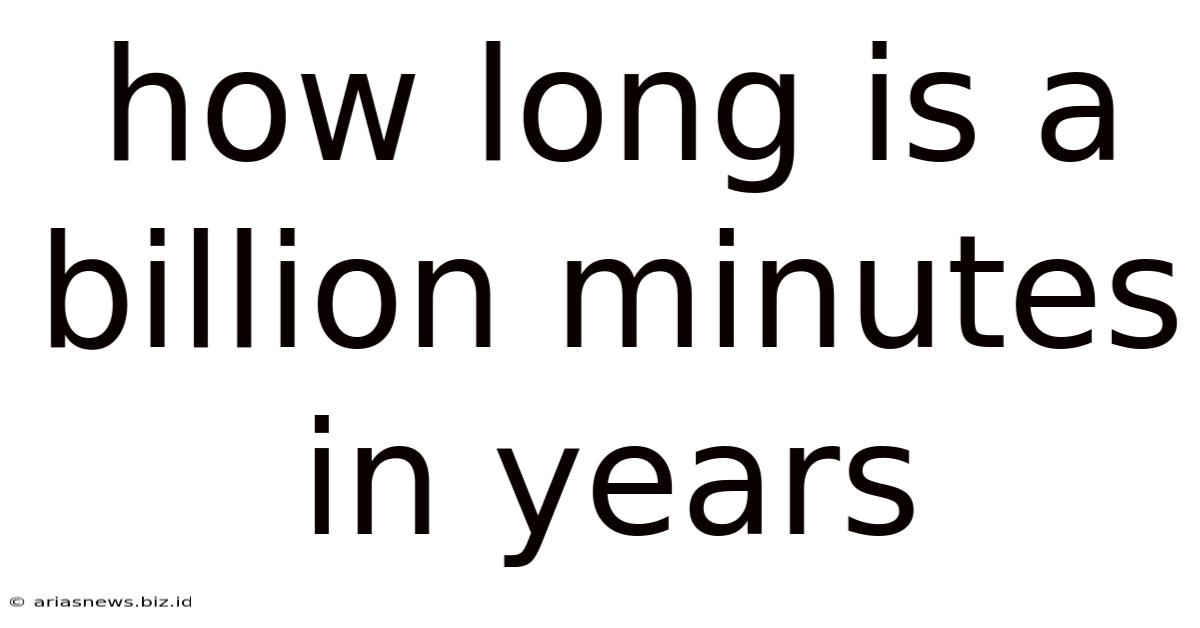How Long Is A Billion Minutes In Years
Arias News
May 11, 2025 · 4 min read

Table of Contents
How Long is a Billion Minutes in Years? A Deep Dive into Time Scales
Have you ever stopped to consider the sheer magnitude of a billion? It's a number so vast it's almost incomprehensible. But let's tackle a specific, intriguing question: how long is a billion minutes in years? This seemingly simple question opens a door to exploring concepts of time, scale, and the power of mathematical conversion. We'll delve deep into the calculations, explore the implications of such a vast timescale, and even consider some interesting real-world applications.
Understanding the Calculation: From Minutes to Years
The core of this question lies in converting units of time. We need to move from the smaller unit (minutes) to the larger unit (years). This involves a series of straightforward calculations, but the sheer magnitude of the numbers requires careful attention.
Breaking Down the Conversion
First, we need to establish the fundamental relationships between units of time:
- 60 minutes = 1 hour
- 24 hours = 1 day
- 365 days = 1 year (We'll address leap years later)
Now, let's outline the steps to convert a billion minutes into years:
-
Minutes to Hours: Divide the billion minutes by 60 to find the total number of hours. 1,000,000,000 minutes / 60 minutes/hour = 16,666,666.67 hours
-
Hours to Days: Divide the total hours by 24 to find the total number of days. 16,666,666.67 hours / 24 hours/day = 694,444.44 days
-
Days to Years: Divide the total days by 365 to find the total number of years. 694,444.44 days / 365 days/year = 1901.76 years
Therefore, a billion minutes is approximately 1901.76 years.
Accounting for Leap Years: Refining the Calculation
Our initial calculation used a standard year of 365 days. However, the Gregorian calendar incorporates leap years every four years (with some exceptions for century years). This means our calculation needs a slight adjustment for greater accuracy.
The Leap Year Factor
Leap years add an extra day every four years, making the average year slightly longer than 365 days. To account for this, we can use an average year length of approximately 365.25 days.
Let's recalculate using this more precise average:
- Days to Years (with leap year adjustment): 694,444.44 days / 365.25 days/year = 1900.9 years
This adjusted calculation provides a more accurate result, showing that a billion minutes is approximately 1900.9 years. The difference might seem small, but it highlights the importance of considering all relevant factors for precise results in large-scale calculations.
Exploring the Implications of 1900 Years
The sheer scale of 1900 years is staggering. This timeframe encompasses significant historical periods, technological advancements, and societal transformations. Let's consider some illustrative examples:
-
Ancient History: A billion minutes stretches back well before the birth of Christ, encompassing the rise and fall of numerous empires, the development of major religions, and fundamental shifts in human civilization. We could be talking about the era of the Roman Empire, or even before that.
-
Medieval and Renaissance Periods: This vast timeframe covers the entirety of the Middle Ages, the Renaissance, and the Age of Exploration – periods marked by profound changes in art, science, and politics.
-
Modern History: Even after reaching the present day, we still have hundreds of years remaining within the billion-minute timeframe. This remaining time represents an expanse of potential future developments.
Practical Applications and Real-World Examples
While seemingly abstract, understanding time scales like a billion minutes has practical implications in various fields:
-
Data Science and Computing: In analyzing massive datasets, understanding the time it takes to process information is crucial. Converting time units can help estimate project durations and optimize algorithms.
-
Financial Modeling: Long-term financial projections require understanding time scales for accurate forecasting. Converting time units is critical in constructing models and evaluating investment strategies.
-
Astronomy and Cosmology: Astronomical events unfold over vast periods. Converting time units enables comparisons and calculations across different cosmic scales.
Beyond the Billion: Exploring Even Larger Time Scales
While a billion minutes is a significant amount of time, it's merely a starting point when exploring the vastness of time. Consider trillions or even quadrillions of minutes. These mind-boggling scales push the boundaries of human comprehension and highlight the limitations of our everyday understanding of time.
Conclusion: A Journey Through Time
Our journey to determine the length of a billion minutes in years has not only provided a numerical answer but also opened up a broader discussion about the nature of time, scale, and the significance of precise calculation. From ancient civilizations to future possibilities, the 1900-year span represented by a billion minutes underscores the immensity of time and the continuous evolution of our world. The exercise showcases the importance of converting units, considering the impact of leap years, and appreciating the remarkable scale of a billion. It's a journey that transcends simple mathematics and provides a compelling perspective on the vastness of time itself.
Latest Posts
Latest Posts
-
How Many 1 8 Teaspoons In 1 4 Teaspoon
May 12, 2025
-
Napa 21348 Oil Filter Fits What Vehicle
May 12, 2025
-
How To Say My Love In Portuguese
May 12, 2025
-
How Long Does It Take Pasta To Digest
May 12, 2025
-
How To Round To The Nearest 10 Thousand
May 12, 2025
Related Post
Thank you for visiting our website which covers about How Long Is A Billion Minutes In Years . We hope the information provided has been useful to you. Feel free to contact us if you have any questions or need further assistance. See you next time and don't miss to bookmark.